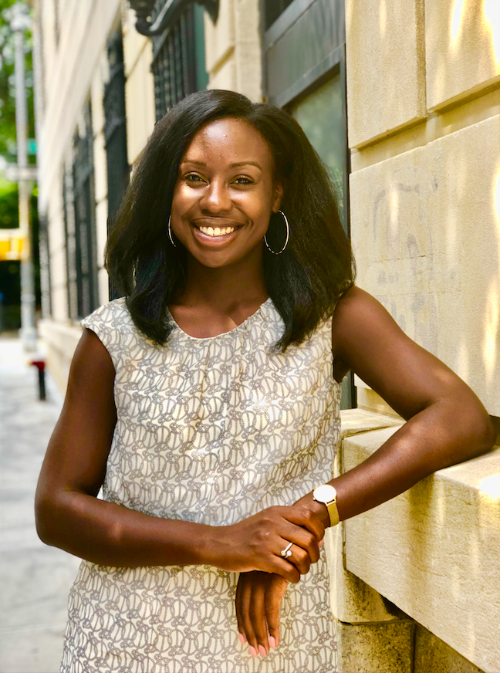Student Spotlight
Kelita Waterton

Hometown: Brooklyn, New York
Degree Program: MD/MPH, Epidemiology concentration
Class Year: 2023
Undergraduate Major: Human Biology, 2016
Professional Interests: Healthcare Disparities
Extracurricular Activities/Involvement:
- Public Relations Chair for Daniel Hale Williams Society
- Peer Wellness Mentor for Downstate PeerMentorship & Wellness Program
- Patient Education Volunteer for Brooklyn Free Clinic
- Marketing Manager for Downstate Initiative for Nutritional Empowerment
- Tour Guide Coordinator for Office of Student Admissions
Click here for Kelita Waterton’s LinkedIn profile
1. What drew you to the MD/MPH program at SUNY Downstate Health Sciences University? Why did you choose to study public health?
I was born and raised in Brooklyn. Though becoming a physician seemed like a dream to me, I always thought of SUNY Downstate as a place where it could come true. SUNY Downstate has always been an institution held with high regard in the Brooklyn community for its dedication and outreach. As I began to learn more about medicine and health care, I started to recognize that not all patients received the same standard of care. I became passionate about health inequities and the effects of social determinants of health. I always knew I wanted to become a physician and that I wanted to be trained and practice medicine in my hometown, but I also came to realize that I wanted to do my due diligence and learn how to tackle health disparities from multiple angles. I knew SUNY Downstate would not only train me to be a great doctor but also a great researcher and public health advocate.
2. What is your favorite aspect of the program and what have you gained from it?
One thing that I love about the MPH program is the inter-professional relationships that I have been able to develop, not only with the faculty but also other students as well. I have shared classes with physicians, nurses, and other students with various professional backgrounds. It opens up the opportunity to have class discussions that span across many different fields and life experiences.
3. Can you recall a memorable in-class or general SUNY Downstate experience that struck you as particularly meaningful?
As a part of the medical curriculum, we have “patient presentations” and in one particular session we were able to interact with patients with various rheumatic conditions. This session was particularly impactful because we got to meeting patients from various backgrounds and clinical presentations of the very same conditions we were studying. Most of the patients were patients of color, which is often not represented in medical textbooks. One patient that had gout for many years and presented to us with tophi on several of his joints. What was especially striking about our interaction with him, is that for a long time, no one truly explained to him what it was that he had or what he or the physicians could do for long term prophylactic treatment and preventative measures. He went years with only temporary treatment until he came to Downstate and was given medication for chronic management. This provided us with a real-life reminder to be the kind of physician that will not only treat the patient but also educate them and help them to have better long-term health outcomes.
4. Could you describe your activities and involvement at SUNY Downstate?
Here are some of the extracurricular activities I have been involved in:
As a mentor in the Downstate Peer Mentorship & Wellness Program, along with my partner, I meet with a group of 12 first year medical students several times a semester and provide them with a safe space to address mental and emotional wellness. In these meetings, we discuss strategies to manage stress and maintain relationships and facilitate discussions on their medical school experience.
Daniel Hale Williams Society is the SUNY Downstate chapter of The Student National Medical Association (SNMA). As an organization, SNMA supports underrepresented medical students and underserved communities. As the Public Relations chair for the Downstate chapter, I have helped to coordinate and advertise events for our student body as well as operating and creating content for our social media platforms.
Brooklyn Free Clinic (BFC) is a Downstate affiliated student run clinic that is completely free of charge for patients who are underinsured or uninsured. As patient education volunteers, we hold health education workshops and projects for BFC patients and provide information about several health topics such as diabetes or heart disease.
5. What are your goals? Do you have plans to further your education or do you have a career in mind upon graduation?
As a second-year medical student, I am still undecided in what field of medicine I will practice as a physician, though, I have interests in dermatology, anesthesiology, hematology, and endocrinology. I am excited to learn as much medicine as I can in these next few years that I can be the best doctor that I can for my patients. My ideal goal is to practice medicine in NYC and to use my public health education to advocate for my patients and their communities.
6. Do you have any advice for someone who might be interested in Downstate’s MD/MPH program?
Medicine and public health are being integrated more as healthcare advances. As a MD/MPH student you have the unique advantage of being at the frontlines of that change. The COVID-19 pandemic has illustrated to us that while the virus has had devastating effects on many communities globally, data has shown that patients of color and patients of lower socioeconomic status are particularly vulnerable. That is a modern-day example of why training in both medicine and public health is needed to help push the health of our nation forward. If that is something that interests you, I say go for it! And when you in those classes, you will see how much public health has become an important part of our medical training and how medical training can help make our public health efforts more impactful.